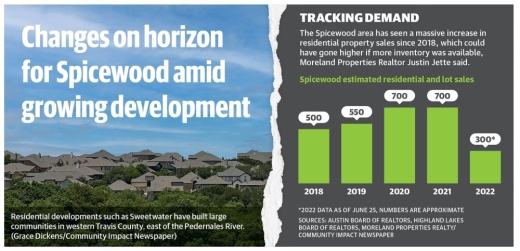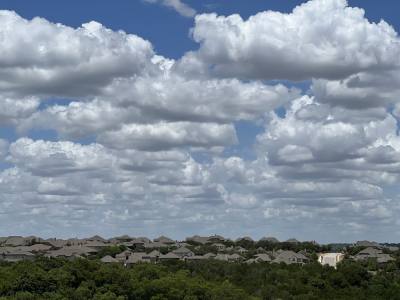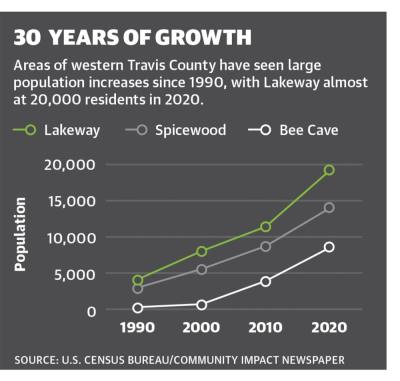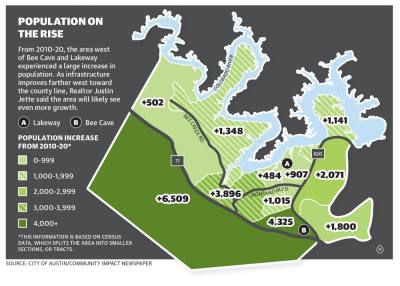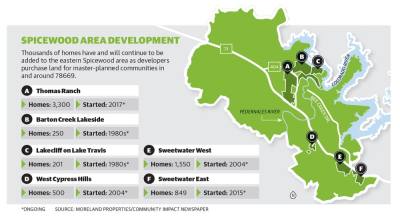In the early 1900s, his birth town was primarily a farming community, where his grandfather and father picked cotton to feed a bustling local cotton industry. Though he later moved away, Lewis returned to the family ranch after inheriting land from his father. He now lives in a home originally constructed in the 1850s, on land that has been in his family for more than 100 years.
“A lot of [land] is being developed now,” Lewis said. “There are a lot of families around here that still have land that’s been in their families for over 100 years, but it’s slowly going away, some of it. As development comes, the ranch man goes.”
In 2018, there were just under 500 home sales in the Spicewood ZIP code area, according to data from the Austin Board of Realtors and the Highland Lakes Association of Realtors. This number grew to more than 700 in 2020 and 2021. This number likely would have gone much higher if not limited by inventory, said Justin Jette, a Realtor with Moreland Properties in the Spicewood area. Home sales in 2022 already were nearly 300 as of June 25.
As Austinites continue to sprawl westward from central Travis County into residential developments and custom homes, longtime residents such as Molly Parker said they are worried Spicewood will lose its special spark.
“Everybody loves being out here because everybody’s on acreage. But the other side of that is now the subdivisions are coming in,” Parker said.
History of development
Spicewood is a sprawling unincorporated area west of Lakeway that spans Burnet and Travis counties from west of Bee Creek Road all the way to Marble Falls. With no local city government or centralized hub, this piece of the Hill Country is often an enigma to anyone unfamiliar with the area, Parker said.
“Spicewood is rarely on anybody’s radar because it’s not incorporated like Rollingwood or those other cities,” Parker said. “People don’t understand what Spicewood is.”
Development began to boom in western Travis County in 1962 following the purchase of 2,700 acres of ranch land in what is now Lakeway, according to the city and historian Lewis Carlson. A subsequent purchase more than doubled the acreage for development, and in 1963 property sales began.
By 1971, there were 300 homes in Lakeway and about 1,000 acres developed. To avoid annexation, residents voted to incorporate and became the village of Lakeway in 1974. Bee Cave was seeing its own growth during this time, and in 1987 the 2-square-mile community incorporated and became the village of Bee Cave, according to the city.
As development in the two sister cities has grown over the years, expansion has continually moved westward toward Spicewood. For instance, Lake Travis ISD began operation in 1981, and in years since has opened a middle school and elementary school in the Spicewood ZIP code. An additional elementary school located near the middle school was approved in May.
Population totals for Lakeway, Bee Cave and Spicewood each range from 14,000-19,000. Though these numbers look similar on the surface, the areas accounted for in Bee Cave and Lakeway are significantly smaller compared to Spicewood, according to maps from the city of Austin.
“It’s kind of unique in that [Spicewood] covers a big geographic area, but there isn’t much of a town center,” Jette said. “The area is starting to see the beginnings of a lot of new growth that will be coming in the next few years.”
Ongoing developments
As more and more families have been looking to escape the city life of Austin, considerable growth has been seen east of the Pedernales River, Jette said. In search of larger plots and a slower pace, this has resulted in families moving westward into Bee Cave, Lakeway and now Spicewood.
“The biggest growth has definitely been east of the Pedernales [River], but I think the west is about to come into its own,” Jette said.
Spearheaded by Newland Communities, Sweetwater is a master-planned community south of Hwy. 71. The development is split into two parts, Sweetwater West and Sweetwater East, which were approved by the city of Bee Cave in 2004 and 2015, respectively.
Sweetwater West is across from Lake Travis Middle School and encompasses the area surrounding Pedernales Summit Parkway. The 1,400-acre development will include 1,550 homes when fully built out, according to Moreland Properties.
Sweetwater East extends just past Serene Hills Drive to the eastern side of Pedernales Summit Parkway. The 403-acre mixed-use development will include 849 units of single or multifamily homes when fully built out. Alongside the residential real estate, the site also has commercial real estate off of Hwy. 71 for retail and office space, according to Moreland Properties.
West Cypress Hills is another major development consisting of roughly 500 homes, totaling more than 1,000 acres of land west of Sweetwater.
Building began in the neighborhood in 2004 and continues today. Sweetwater and West Cypress Hills represent traditional neighborhood build-outs in the area, Jette said.
“They’re already established out there and ... started the newer growth out in that direction, offering a more traditional scenario at what used to be lower prices,” Jette said.
Significant growth has taken place in the last 20-30 years off Paleface Ranch Road, with the subdivisions Lakecliff on Lake Travis and Barton Creek Lakeside. Thomas Ranch is an upcoming development off the road that was approved in 2017.
Located on 2,200 acres, Thomas Ranch will be one of the largest residential developments in the area with about 3,300 homes, apartments, restaurants, a hotel, marketplace shops and more, according to plans approved by Travis County. The project is estimated to take two decades to complete and will have a population of 6,000-10,000 people.
“There has been so much development in just the last five years; it’s overwhelming,” Parker said. “These are major, major communities right here on [Hwy.] 71. It’s just all going to change.”
Alongside residential developments, businesses have also found fertile ground in the area. As a seasoned Spicewood resident himself, Dewey Hollingsworth said he has maintained several business ventures since moving there in 1957.
Hollingsworth owns Hollingsworth Real Estate Group, a recreational vehicle park, a self-storage service and formerly ran an insurance business in the area, alongside other endeavors. Interest in the area has grown throughout the years, with convenience stores, small medical facilities and variety stores trying to buy land in the area, Hollingsworth said.
“You’re going to see growth,” Hollingsworth said. “There’ll be offices, different types of businesses that will help our community. It’s going to grow, no ifs or ands about it.”
In Spicewood, several of the buildings currently have a “countryside” building style, such as the Spicewood General Store and the strip of businesses next door. A concern of residents is losing the “country charm” of the area as development continues, Hollingsworth said.
Growth in Spicewood has a somewhat different trajectory, given the unique challenges of building in the area, Jette said. The main problem is water; if residents or developers cannot get the necessary water supplies, building is untenable.
In coming years, Jette said that reasoning will be less viable as more infrastructure is brought to the area by developers in response to growing demand.
Looking toward the future
Interest in commercial and residential ventures will likely only grow in coming years, Jette said. For instance, Mighty Fine Burgers has plans to open a Spicewood location in July.
As development continues its westward creep toward Spicewood, Parker said she hopes the community can find a happy medium between development and Hill Country living.
“I think what everybody’s really concerned about is preserving the beauty of this area—the thing that makes it so special, not wanting to lose that,” Parker said.
From his front porch, Lewis said he has a clear view across the lake and can see the signs for stores on the far side.
But for Spicewood, a former farming and cattle community-turned prospering focal point for residential real estate and business, change may be on the horizon, Lewis said.
“Right now I don’t have to look at [any] houses; all I see is Hill Country,” Lewis said. “Maybe not in my lifetime, but for my kids, there’s just going to be more and more population. You have a lot of undeveloped [land], but a lot of it’s being developed now.”




